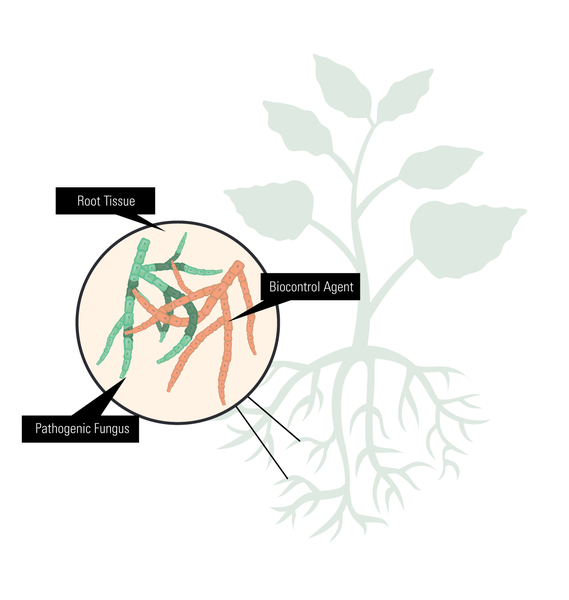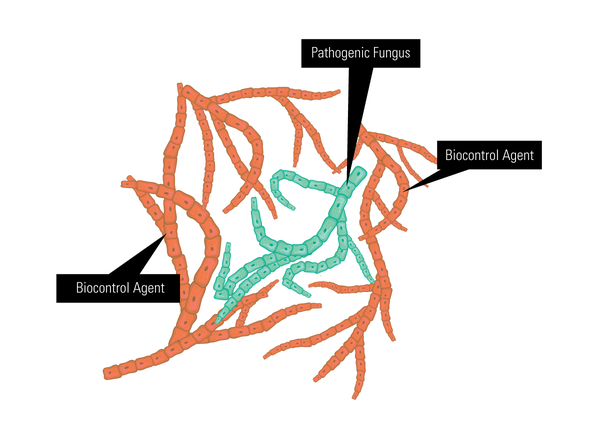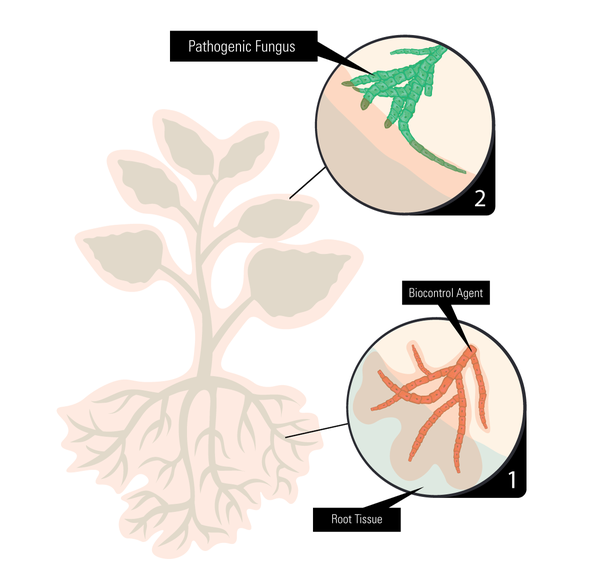What Are Biopesticides?
Biopesticides, which include products that contain biological control agents (BCAs) or are derived from organisms or products found in nature, are used to manage diseases and pests. Biological control agents (BCAs) are living organisms that suppress plant diseases. These are most often bacteria or fungal species that interact with the causal agent(s) of disease, including other bacteria and fungi, as well as nematodes. Most BCAs are natural inhabitants of the soil and have few or no negative effects on off-target organisms or the environment. In addition to living organisms, extracts from plants, exudates from living organisms, and other natural substances are also utilized as active ingredients in biopesticides. Similar to synthetic pesticides, biopesticides must be registered for use by the Environmental Protection Agency (EPA). A few biopesticides have ingredients that the EPA found to be sufficiently safe to be exempt from the registration process.
How Do Biopesticides Control Plant Diseases?
Numerous microorganisms, such as bacteria, fungi, viruses, and nematodes, interact with plants in the natural environment and with each other. Some microorganisms may benefit the plant by facilitating the uptake of nutrients from the soil. Some have no known negative or positive effects on the plant, while others act as pathogens and cause disease under favorable environmental conditions. Microorganisms may also benefit, have no effect, or harm each other. Biological control utilizes antagonist interactions between a BCA and/or a natural product, and a plant or pathogen to control disease. There are numerous mechanisms of antagonism (Table 1) used by biopesticides that contain BCAs and/or natural products. Many biopesticides are considered broad spectrum because the mechanism of antagonism is not specific to a particular pathogen.
| Mechanism | Examples of products |
|---|---|
| Hyperparasitism/predation | Streptomyces sp. (Mycostop, Mycostop Mix, Actinovate AG) |
| Trichoderma spp. (Rootshield, Rootshield Plus) | |
| Secretion of toxic compounds | Bacillus subtilis (Serenade ASO, Cease, AVIV, Companion) |
| Streptomyces sp. (Actinovate, Mycostop, PreFence) | |
| Toxic compounds | BLAD polypeptide (Fracture) |
| Extract of Swinglea glutinosa (EcoSwing) | |
| Burkholderia rinojensis strain A396 (heat-killed) and spent fermentation media (Majestene) | |
| Competition* | Bacillus amyloliquefaciens (Stargus, Amplitude, Serifel) |
| Streptomyces sp. (Mycostop, Mycostop Mix, Actinovate AG) | |
| Trichoderma spp. (Rootshield, Rootshield Plus) | |
| Induction of host resistance* | Bacillus amyloliquefaciens (Stargus, Amplitude, Serifel) |
| Bacillus mycoides (LifeGard) | |
| Bacillus subtilis (Serenade ASO, Cease, AVIV, Companion, Taegro 2) | |
| Extract of Reynoutria sachalinensis (Regalia) | |
| Trichoderma spp. (Rootshield, Rootshield Plus) |
*An indirect form of antagonism
Hyperparasitism/predation:
A parasite or predator benefits from obtaining nutrients from a pathogen while the pathogen is harmed. With biological control, a BCA would feed on, and may eventually kill, a pathogen. See Figure 1.
Secretion of toxic compounds:
Toxins such as antibiotics and lytic enzymes are secreted by an organism and directly inhibit another organism’s growth and/or reproduction or kill the organism. With biological control, a BCA secretes an antibiotic that disrupts the cell membrane function of a pathogen and kills it. Alternatively, a chemical that is naturally secreted by an organism and is toxic to a target pathogen may be extracted or manufactured and used in a biopesticide. See Figure 2.
Competition:
An organism that consumes all the food and/or occupies all the space in an area, which inhibits another pathogenic organism from being in the same space. This is an indirect form of antagonism because there is no direct interaction between the organisms. With biological control, a BCA would colonize the root system of a host plant and prevent a pathogen from infecting the root system. See Figure 3.
Induction of host resistance:
An organism interacts with a plant and induces a series of metabolic reactions, which include physical and chemical changes that inhibit plant infection by pathogens. This is a form of indirect antagonism because there is no direct interaction between the organisms. With biological control, a BCA would colonize the root system of a host plant and induce a cascade of chemical responses that stimulate the plant to defend itself against pathogens. A pathogen that tries to infect the plant is then inhibited by these chemical and/or physical changes in the plant tissue. See Figure 4.
How Are Biopesticides Used to Control Diseases of Vegetables?
Many vegetable diseases are caused by bacterial and fungal pathogens. Products derived from nature, as well as BCAs, have been incorporated into biological control products to control pathogens. As shown in Table 1, many commercially available biopesticides and biochemicals use more than one mode of action and are efficacious against numerous pathogens.
When using biopesticides, it is important to remember that many products contain living organisms that are sensitive to environmental conditions. Thus, biopesticides may not perform as consistently as synthetic chemicals in the field. These products can be used in a conventional program, although it is critical to consult the label for compatibility with synthetic products or to consult with your pesticide representative.
Under conditions with high levels of disease, many biopesticides may fail. Biopesticides must be applied preventatively. Success depends on the additional implementation of cultural practices that limit disease. As in a conventional disease management program, keeping a record of disease history, as well as obtaining an accurate diagnosis when a disease arises, is critical to the successful implementation of a biopesticide program.
If you are an organic grower, it is important to know that most, but not all biopesticides are National Organic Program (NOP) compliant. Consult the Organic Materials Review Institute (OMRI) listed products page for a list of products reviewed and listed by the OMRI.
For current information on the use of biopesticides to manage vegetable diseases in the Southeastern United States, consult the Southeastern US Vegetable Crop Handbook or the North Carolina Agricultural Chemicals Manual.
Acknowledgments
Thank you to Dr. Margaret McGrath, Cornell University, for reviewing this publication and providing suggestions for improvement. Thank you also to Alta Zhang, Extension Information Technology, North Carolina State University, for creating the figures.
Publication date: May 17, 2022
AG-917
Recommendations for the use of agricultural chemicals are included in this publication as a convenience to the reader. The use of brand names and any mention or listing of commercial products or services in this publication does not imply endorsement by NC State University or N.C. A&T State University nor discrimination against similar products or services not mentioned. Individuals who use agricultural chemicals are responsible for ensuring that the intended use complies with current regulations and conforms to the product label. Be sure to obtain current information about usage regulations and examine a current product label before applying any chemical. For assistance, contact your local N.C. Cooperative Extension county center.
N.C. Cooperative Extension prohibits discrimination and harassment regardless of age, color, disability, family and marital status, gender identity, national origin, political beliefs, race, religion, sex (including pregnancy), sexual orientation and veteran status.




